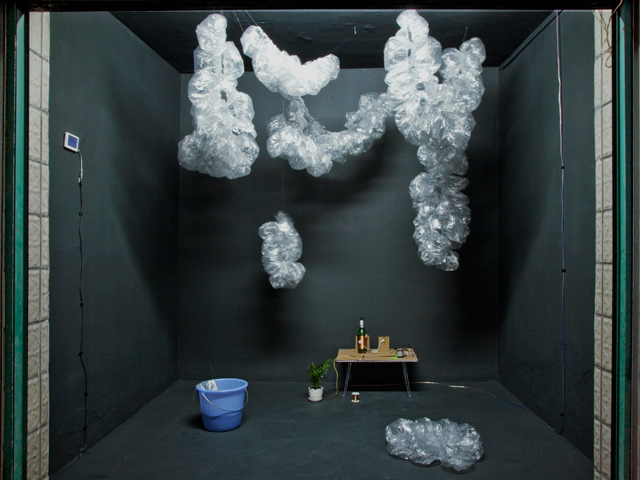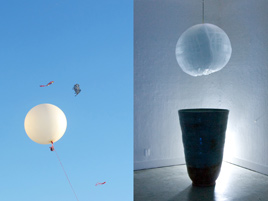| A Pail of Air |
兼容的盒子计划第五十四期 bazaar compatible program #54
31°12.246'N 121°25.010'E
一桶空气 A Pail of Air
陈莉丽的现场计划 project space by Lili Chin
2013/09/02 - 2013/09/07
谢尔莎-海根与陈莉丽的装置对话 dialogue installation by Saoirse Higgins & Lili Chin
2013/09/08 - 2013/09/15
安顺路98号 小商品市场内26号铺 Shanghai, 98 Anshun Road, stall 26
"A Pail of Air" explores the upper atmosphere and outer space with works by Lili Chin and Saoirse Higgins. This dialogue installation began with a shared interest in themes of planetary disaster and means of survival. Using the post apocalyptic era as a point of departure, Saoirse and Lili join forces to explore narratives of earthly imbalance, element and technology. Shower caps paired with sounds emanating from bottles fuse into an other worldly terrain. Both familiar and foreign, this wake of re-contextualized objects find themselves situated casually in a Shanghai market. The show develops organically, first open to the public as a project space for one week beginning on September 2nd, then finally arriving at the shelter's final development on September 8th with a formal week long exhibition.
"A Pail of Air" refers to the title of a fantastical fiction short story written by Fritz Leiber, which appeared in the December 1951 issue of Galaxy Magazine and was dramatized on the radio show X Minus One in March 1956.
Lili Chin & Saoirse Higgins
Shanghai, August 28, 2013
 |
    
|
*The story is narrated by a ten-year-old boy living on Earth after it has been torn away from the Sun by a passing "dark star". The loss of solar heating has caused the Earth's atmosphere to freeze into thick layers of "snow". The boy's father had worked with a group of other scientists to construct a large shelter, but the earthquakes accompanying the disaster had destroyed it and killed the others. He managed to construct a smaller, makeshift shelter called the "Nest" for his family, where they maintain a breathable atmosphere by periodically retrieving pails of frozen oxygen to thaw over a fire. They have survived in this way for a number of years. At the end, they are found by a search party from a large group of survivors at Los Alamos, where they are using nuclear power to provide heat and have begun using rockets to search for other survivors (radio being ineffective at long range without an ionosphere). They reveal that other groups of humans have survived at Argonne, Brookhaven, and Harwell nuclear research facilities as well as in Tanna Tuva, and that plans are being made to establish uranium mining colonies at Great Slave Lake or in the Congo region.
